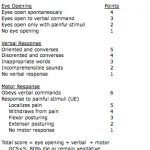I received quite a bit of feedback from yesterday’s column. Obviously this topic strikes a chord with my readers. Here was one well thought out comment from Tim Kaye in California:
I have worked for 15 years as a paramedic in a very busy EMS system in Northern California. When I was new, I used to fight to make myself heard in the trauma room, only adding to the din and chaos, which was usually – and rightly so – squelched by a decisive bark from the trauma team leader for quiet as they assesed the critical patient. What I came to realize was that if I wanted to benifit my patient, I needed to re-invent how I was taught to give my reports. Instead of trying to include everything in a minutes-long speech, I would instead follow this pattern:
1) Ask as I was walking in who I would give report to, thereby establishing clear communication and not just shouting to no one in particular.
2) A very brief, one sentence explination of MOI, and I forced myself to hold fast to the one sentence rule.
3) Critical findings/life-threats were reported next, followed by any interventions. This gave the trauma team leader an idea of where to focus their exam for similar life-threats.
4) I would give only selected vital signs in my rapid report. These included anything aberant or concering, followed by heart rate, respiratory rate and end-tidal CO2 on all patients.
5) I would conclude by asking the trauma team leader specifically if they had any immediate questions.
Because I structure and practice this method, my reports typically last about 20-30 seconds. Realizing that there are major gaps in the initial report, I then go and speak directly to the scribe and fill in those gaps with such information as further description of MOI, a complete set of vital signs and trends, blood glucose, IV sites, etc.
This method allows for rapidly communicating vital information quickly, and detailed information to the appropriate staff member at the appropriate time.
To tie up any loose ends, after I completed my charting, I ALWAYS stop by the trauma bay and check one last time with both the trauma team leader and the scribe and ask if they have any more questions. As I made this my practice, ER attendings, trauma surgeons and nurses all came to expect this final check-in to clear up any last questions. This worked in a most excellent fashion to provide continuity of care, to develop relationships with all of the staff at our two Level-1 and one Level-2 centers, and for personal education as I checked in to what the diagnosis and course of treatment was for the patient.
I would argue that the handoff is really a two-way process. Tim has found a way to do the right thing in an environment where the other half of the team is too busy / not listening / not aware.
Tomorrow I’ll share what I think is the best approach to this process. Hint: it involves active participation by both sets of trauma professionals.
Related posts:


